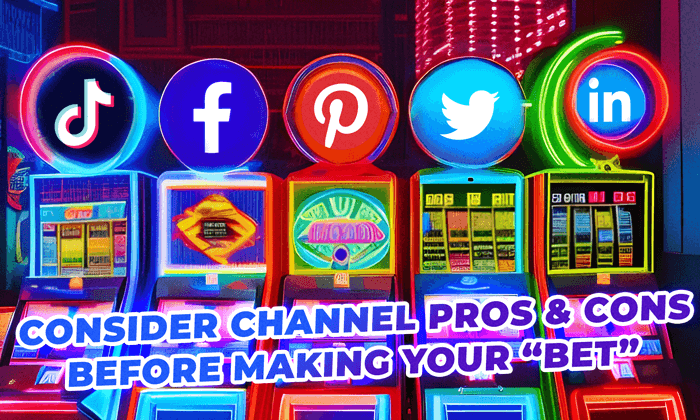In 2022, Elon Musk made headlines by taking over Twitter.
However you feel about the guy, it’s undeniable that the takeover generated a lot of buzz and controversy. And, unfortunately for Musk if there is one thing businesses don’t appreciate – it’s risk.
According to Reuters, more than 500 advertisers have suspended their spending on Twitter, and its daily revenue has dropped 40% compared to the same time last year.
And, tweets like this from Musk aren’t likely to help Twitter get back in advertisers good graces:
Ads are too frequent on Twitter and too big. Taking steps to address both in coming weeks.
— Elon Musk (@elonmusk) January 21, 2023
Similarly, Facebook’s recent changes have had a considerable impact on the automotive and real estate sectors by imposing limitations on posting to Marketplace..
Even tech giant Google isn’t safe. Google search is surprisingly facing a new formidable foe from Microsoft Bing as AI-powered search engines look to be the future of online queries.
Important aside: Bing has been chasing Google for years. I’s honestly nice to see them finally make some headway. I still can’t forget this example of blatant product placement from a 2010 episode of Vampire Diaries. One of my all-time favorite attempts of a brand trying to reach the youths… for all the wrong reasons.
Meanwhile, TikTok is currently the hot new kid at school, but legislators are doing all they can to keep this Chinese owned company in check.
And, these are just a few examples of changes in tech that have happened in the last few months.
Platforms will continue to rise and fall. Just consider the once widespread ubiquity of MySpace, Napster, Netscape, Geocities, and AOL.
The point is, the only thing you can count on in the world of digital marketing is that things will change.
As a business, it’s crucial to avoid taking a passive approach to change by ignoring emerging trends or stubbornly sticking to outdated tactics.
Obviously, you can’t control how a third-party tech giant makes decisions. So, as a business, how can you minimize risk as these changes are bound to happen?
The answer is simple – you need to diversify.
How to Diversify Your Digital Marketing Efforts
If you’re getting all of your leads or sales from one channel, that’s a major marketing red flag.
Whether that channel be Facebook, Google Ads, Twitter, or even an old school marketing channel like tradeshows or email marketing, it doesn’t matter.
Think of your lead generation similarly to how you would a stock portfolio.
Typically, you want a mix of a few high-risk high-reward investments, moderate-risk moderate-reward investments, and low-risk low-reward investments.
This will do a few things:
- Help your business absorb any changes you can’t anticipate.
- Reach a larger audience as diminishing returns on a single platform are bound to happen.
- Keep your brand top-of-mind to target audiences as they browse multiple sites and platforms.
In addition to investing in multiple third-party advertising platforms, it’s also important to build up your owned and earned media channels.
This means investing in tactics like local and traditional SEO, email marketing, and social media in addition to paid advertising .
But, the exact mix of channels you choose to focus on really depends on your target audience and the market you are in.
Diversifying doesn’t mean blindly investing in as many channels as possible. That would be nearly impossible to maintain, especially at a small business.
Instead, it means targeting several that work best for your business and continually phasing channels in and out to see what works for your organization.
How to Target the Right Channels
When it comes to digital marketing, it’s crucial to understand your target audience and where they spend their time online.
What are their job titles, industries, ages, and common interests? Once you have this information, you can start to identify the platforms they use the most.
Regarding advertising channels, Google Ads and Meta/Facebook/Instagram Ads are a a relatively risk-free and reliable way to reach most audiences. But, they also come with more competition, and have become more expensive in recent years.
TikTok is an example of an emerging power player in advertising, but their advertising platform is still new. And, it’s a Chinese-based company, so privacy and potential government restriction should be considered before going “all-in”.
With that in mind, the platform likely also offers high rewards for businesses that can figure out how to successfully leverage its platform before the competition. But, the level of risk/reward involved depends on your target audience.
For example, if your goal is to target younger audiences you’ll likely be able to reach more potential customers, but you’ll also face more competition. Meanwhile, older audiences may offer high rewards with less competition, but also fewer eyeballs as not as many older audiences are on the platform…yet.
These are just a few example of advertising channels your company should explore. Some other top contenders I recommend investigated include: Bing Ads, LinkedIn, Twitter, Pinterest, and YouTube.

In addition to paid channels, earned and shared media channels should be invested in as well.
This includes channels like your website, organic social media, podcasts, traditional and local SEO, PR, customer reviews, and email marketing.
My personal favorite earned media channel is SEO. But, I also wouldn’t recommend these channels for every business or industry.
For example, traditional SEO only works if your target audience is using search engines to research online. To determine how many searches your product or service gets online, you’ll need to conduct research with an SEO tool. My personal favorite is SEMRush.
In short, be strategic about where you market, and don’t be afraid to try new channels. Just make sure to carefully evaluate the risks and rewards for your target audience and industry.
How to Overcome Diversification Challenges When You’re a Small Business
Most small businesses struggle with a lack of marketing resources which can make diversification difficult.
This is one of the biggest reasons it’s important to be strategic about where you devote your time, money, and effort.
Remember, Rome wasn’t built in a day. Start small and work your way up.
And luckily, while constantly evolving technology takes, it also gives!
There are a multitude of affordable resources that make it easier and easier for small businesses to scale their marketing efforts:
- Canva Pro makes it easier than ever to create video and image ads from millions of stock footage for one low monthly price. There is also a built-in social media planner that allows you to schedule your content on 8 different platforms.
- ChatGPT is a game changer for marketing content creation. You can use it for things like brainstorming content ideas, distilling content, and changing your marketing message tone… just to name a few
- Play HT AI voices for video voiceovers and podcasts sometimes perform better than the real thing!
- AI Image creation tools are a great way to create original images for your brand. My current favorite is Night Cafe.
So yes, the ever-changing landscape of digital marketing can pose a risk for B2B businesses, these risks can be largely mitigated through diversification.
A well-rounded digital marketing strategy should include a mix of paid, earned, and owned media channels, such as Google Ads, paid social, organic social, email marketing, and local and traditional SEO.
By diversifying your B2B digital marketing channels, you can reduce risk and ensure your business stays ahead in the ever-evolving digital marketing landscape.
